Another delicious loaf! This rosemary sourdough bread is just a little bit fancy, perfect for dipping in olive oil or a deluxe sandwich (perfect for grilled cheese!). Mixed with a little black pepper, it's subtle enough for everyday.
This is a simple method and the recipe is adapted from our cinnamon raisin sourdough. Use it to make sourdough stuffing for a ground-up flavour boost.
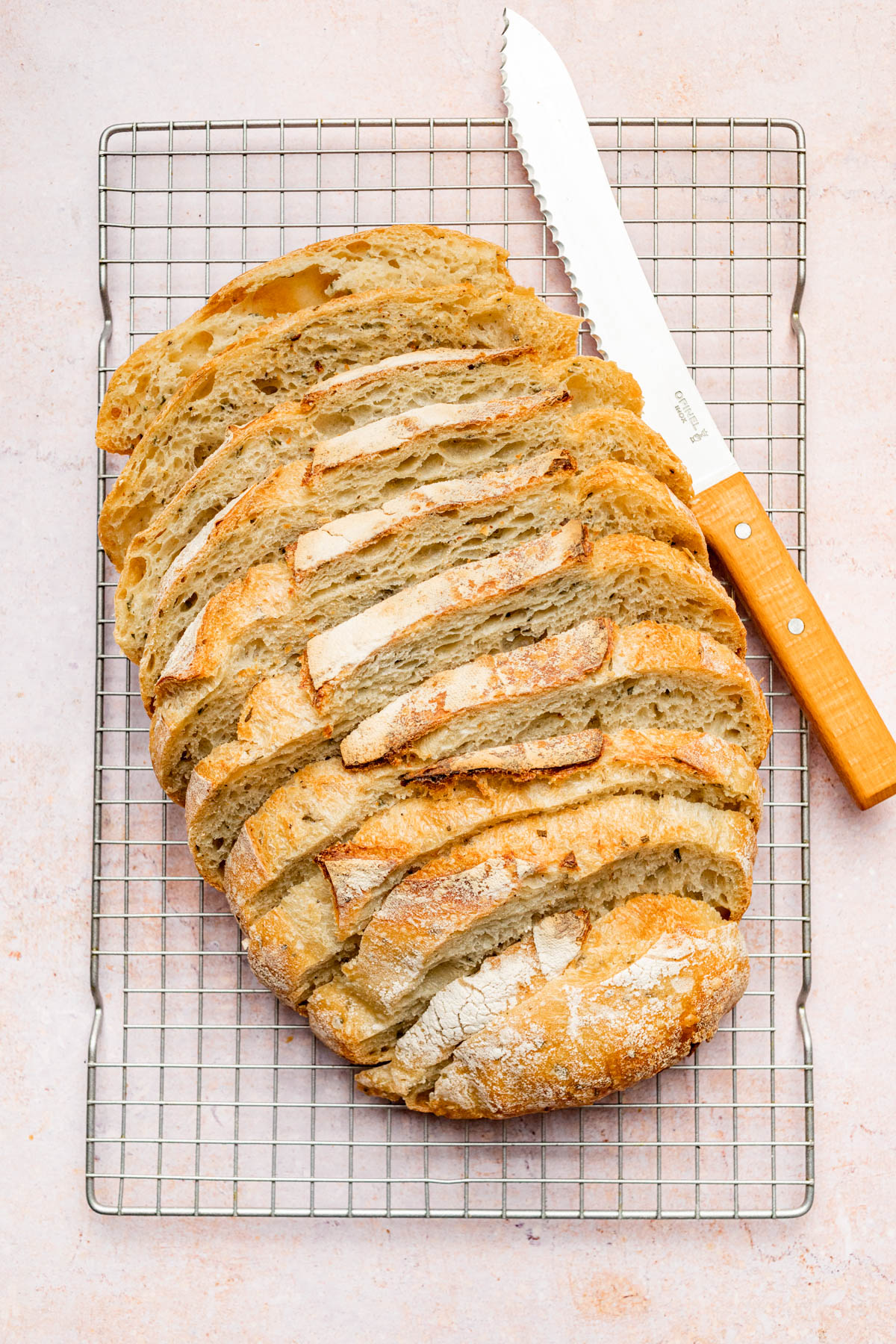
Jump to:
Ingredients
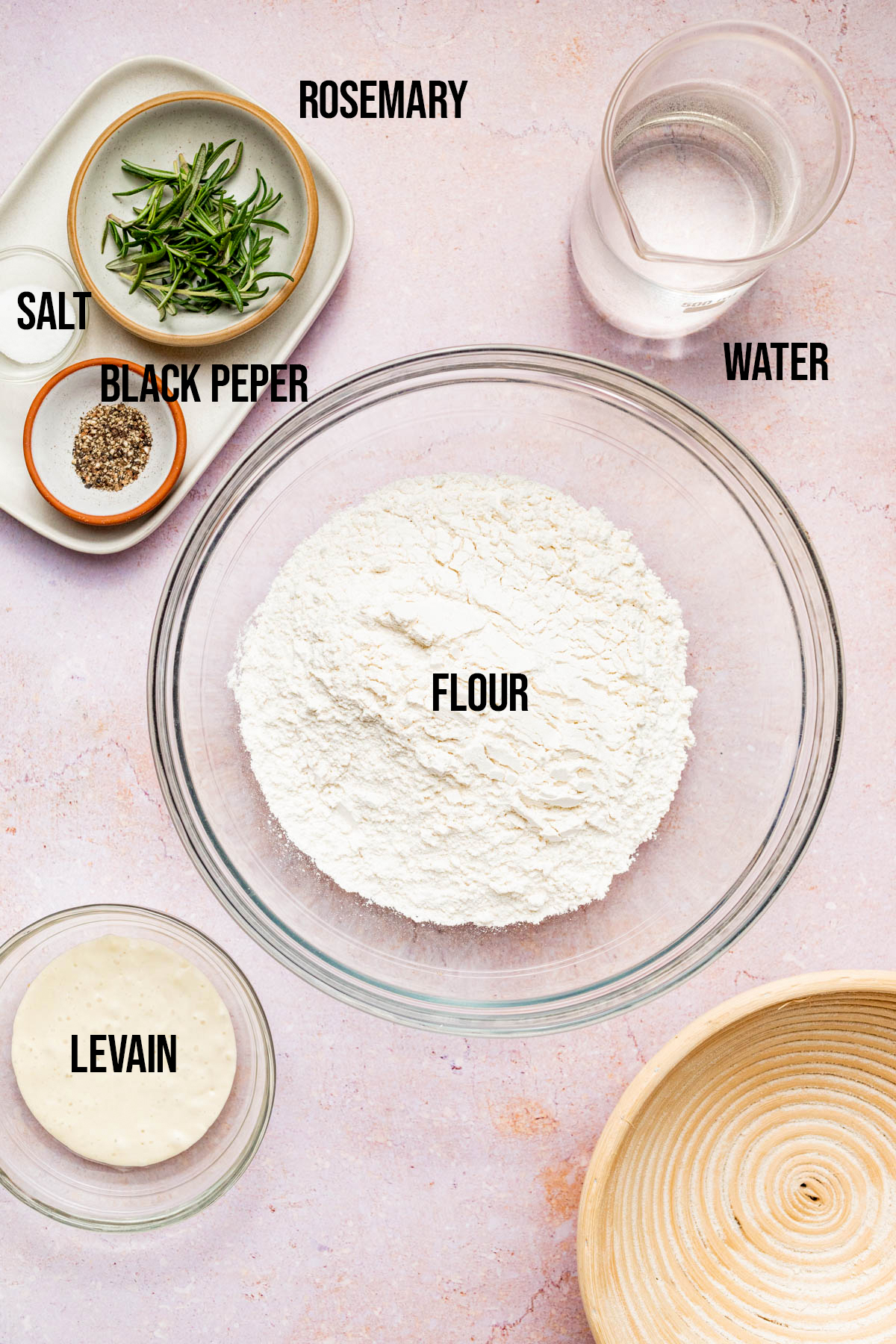
Ingredient Notes and Substitutions
- Flour: use up to 40% (170g) whole wheat flour in this recipe. Either white flour as called for or bread flour can be used.
- Add-ins: try soaked golden raisins, cheddar cheese, chopped olives, and soaked walnuts. Anything that has a tendency to burn should be soaked beforehand.
- Rosemary: use dried or fresh rosemary. If using dried, reduce the amount by half, as it has a stronger flavour.
Method
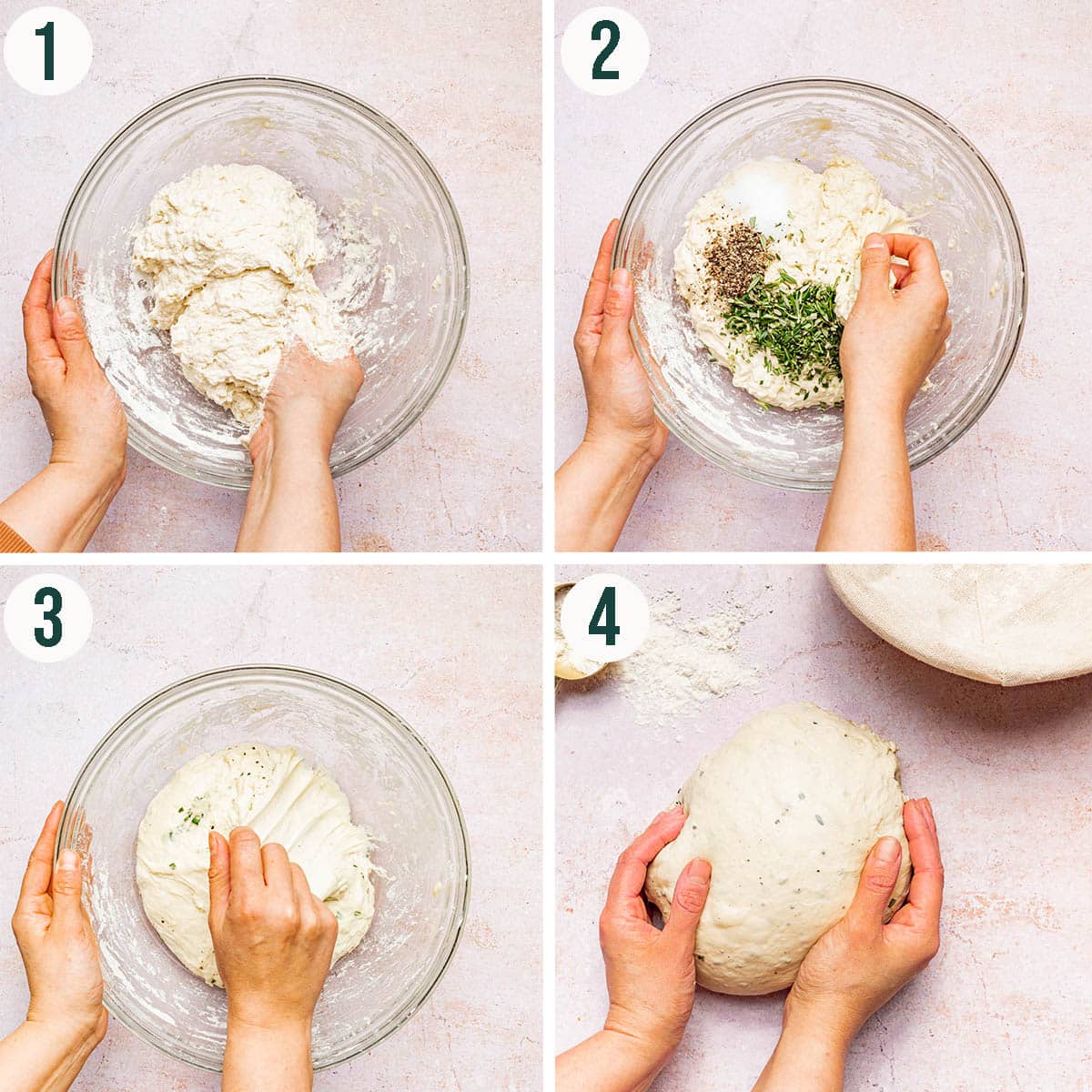
Step 1: add flour, water, and starter to a bowl. Mix and then set aside to autolyse.
Step 2: mix in the salt, rosemary, and pepper.
Step 3: do three rounds of stretches and folds.
Step 4: shape the dough into a boule.
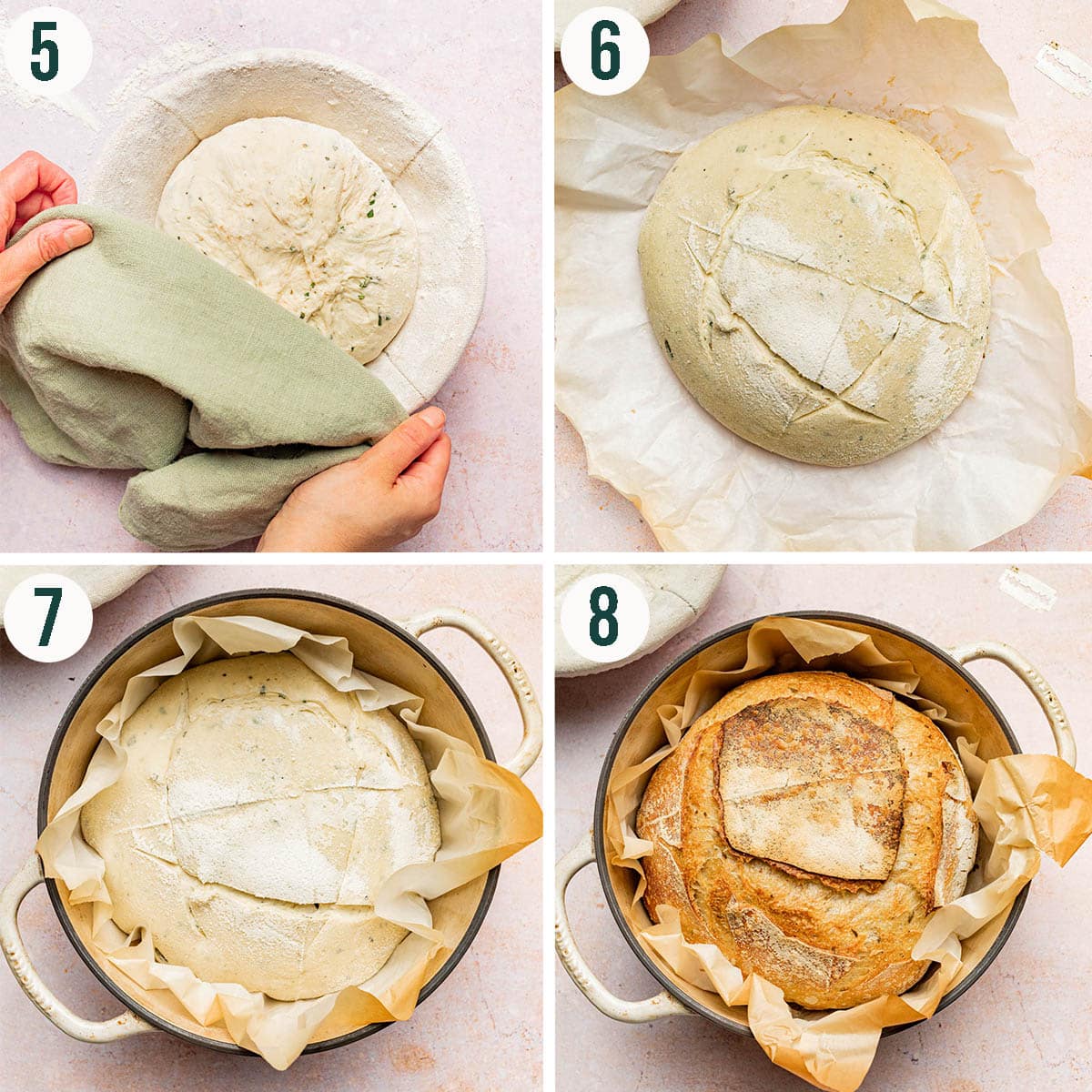
Step 5: set the dough seam-side up into a banneton.
Step 6: once the dough has risen, turn it out onto parchment paper.
Step 7: transfer to a pre-heated Dutch oven.
Step 8: bake for 20 minutes covered and 20 uncovered. Cool before slicing.
Top Tips
- Don't add garlic: our plan was originally to make garlic rosemary sourdough, but we found that the garlic, no matter when it was added, resulted in under-proved bread. If you want a hint of garlic, rub a peeled clove on a freshly toasted slice of bread.
- Start with basics: if you're unfamiliar with the terms used in this post, please see our guides on how to stretch and fold sourdough and how to shape sourdough boules.
- Use any starter: use active sourdough starter or levain for this recipe. Either should be 100% hydration. It can be made with any wheat flour (white, whole wheat, rye, etc.).
How to Store
Storage: sourdough bread is best stored in a paper bag, wrapped in beeswax wrap, or in a bread bin. Keep at room temperature for up to five days.
Freezing: you can freeze the whole loaf or individual slices for up to three months in an airtight container. Slices are great because they can be thawed right in the toaster.

FAQ
What goes well with rosemary in bread?
Rosemary bread is fantastic with a number of savoury spices, like pepper, just about any type of cheese, dried fruit, and nuts. It's particularly good with strong cheeses.
What is the secret to good sourdough bread?
The best homemade sourdough bread is made with good active starter that's had time to mature and strong flour (freshly ground if possible). There's no secret as your water, type of flour, and oven will all make a difference – it's more about personal trial and error.
What do you eat rosemary bread with?
Cheese, especially sharp cheese, is a perfect pairing. Meat - like a chicken sandwich, leftover turkey, or roast beef, grilled mushrooms, caramelized onions, and more.
More Sourdough Bread Recipes
If you make this Rosemary Bread recipe or any other sourdough bread recipes on the Baked Collective, please take a moment to rate the recipe and leave a comment below. It’s such a help to others who want to try the recipe. For more baking, follow along on Instagram, TikTok, and YouTube.
Black Pepper and Rosemary Sourdough Bread
Equipment
- Mixing bowl
- Tea towel
- Banneton
- Parchment paper
- Dutch oven
- sharp knife
- Measuring spoons
- Digital kitchen scale
Ingredients
- 440 grams all-purpose white flour
- 320 grams water at room temperature
- 100 grams active sourdough starter
- 10 grams sea salt
- 2 tablespoons finely chopped rosemary
- 1 teaspoon black pepper ground
Instructions
Day One
- Add the flour, water, and starter to a large bowl. Mix, using your hands, until a shaggy dough forms.
- Once the dough is mixed, cover with a tea towel and let it rest at room temperature for 40 minutes.
- After the elapsed 40 minute resting time, add the salt, rosemary, and pepper. Mix until well combined.
- Do the first fold: To do this get your hands damp and reach under the dough on the opposite side of the bowl from you. Pull the dough up and over towards you. Repeat this so the side closest to you folds over to the side away from you and the side on your left folds towards you right, and your right folds towards your left. Think of it as wrapping a package. Then, scoop your hands under the ball of dough and flip it over completely. This completes one “fold”.
- Complete 6 more folds (one fold every 30 minutes) for 3 hours total.
- Shaping the dough: Begin by taking the dough out of the bowl and letting it rest on the counter for 20 minutes. Meanwhile, prepare your banneton by dusting it with flour (50-50 wheat flour and rice flour is a great dusting combo).
- Shape your dough making sure you get as much surface tension as possible without tearing the outside of the loaf. Once shaped, turn the loaf into the lined and floured bowl or banneton (top-down, seam side up). Gently flour the top (previously the bottom) of the dough.
- Cover with a plate and set the banneton in the fridge overnight, or for at least 8 hours.
Day Two
- The next day, place your dutch oven in the oven and preheat to 260°C (500°F) or as hot as your oven can go, but no higher than 500°F. After the oven has come to temperature, let the dutch oven continue to preheat for another 30 minutes.
- Once the Dutch oven has been preheated, take your bread out of the fridge. Gently invert the dough onto a piece of parchment paper that will be large enough to lift your bread into and out of the dutch oven. Gently score the bread with a sharp knife or bread lame. Using oven mitts, carefully remove the dutch oven from the oven, take off the lid and then carefully lift the dough into the pot using the parchment paper.
- Using oven mitts, carefully place the lid back on the dutch oven and put the entire dutch oven back into the heated oven. Reduce the heat to 230°C (450°F) and bake for 20 minutes. Carefully remove the lid (be careful of steam) and bake for another 20-25 minutes with the lid off.
- Remove the pot from the oven and carefully lift out the loaf using the edges of the parchment paper and let cool completely on a wire rack. If heat makes it too difficult to extract the dough and parchment layer safely, just let the loaf cool in the Dutch oven - don't risk burning yourself.

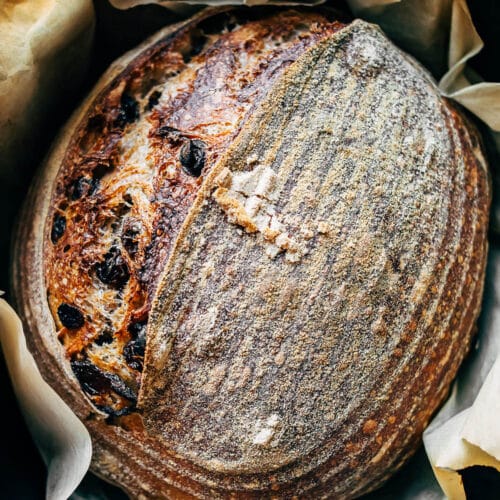

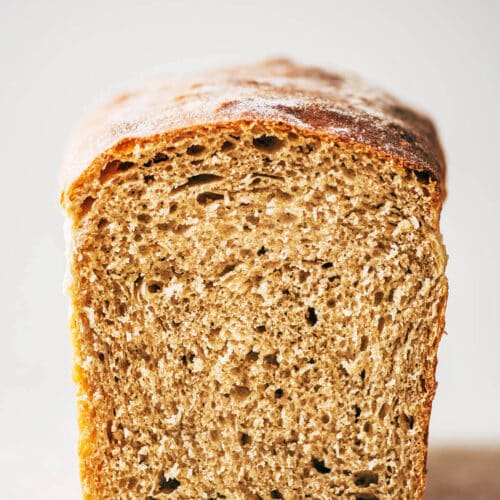


I used this recipe to make my first sourdough loaf. It was delicious and beautiful! Thank you!